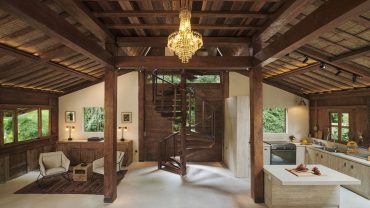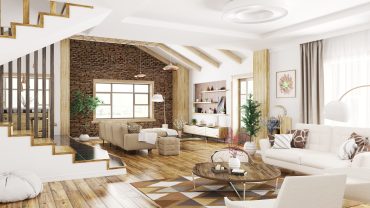In the late 18th century, a wave of fascination with the ancient world swept across Europe and the United States. As explorers uncovered the forgotten ruins of Athens, architects and designers were captivated by the grandeur of ancient Greek temples and the balance in their design. This admiration quickly turned into a cultural movement, giving birth to Greek Revival, a style that reimagined the elegance of ancient Greece for modern living.
From stately columns to refined symmetry, Greek Revival interiors offered a way to bring the timeless beauty of the classical world into everyday spaces. Today, this style remains an enduring symbol of sophistication and harmony, seamlessly blending the old with the new. So, what is Greek Revival interior design in practice and how can it be achieved? Read on to find out.
The Origins of Greek Revival Interior Design

The British Museum is a stunning example of Greek Revival design (Credit: ilbusca via Getty Images)
Greek Revival interior design was preceded by Greek Revival as an architectural style. This, in turn, has its roots in the late 18th century. Until then, Western Europe was largely uninformed about Ancient Greek architecture and design. An important step towards its wider dissemination was the publication of The Antiquities of Athens in three parts, from 1762 to 1795. Written and illustrated by architects James Stuart and Nicholas Revett, this contained detailed depictions and descriptions of hundreds of monuments and architectural elements, the result of the first ever accurate survey of Athens’ archaeological sites. Most famous among these were the temples of the Acropolis, like the Parthenon and the Erechtheion.
One of the first major Greek Revival builds in Europe was Berlin’s Brandenburg Gate, designed by Carl Gotthard Langhans and completed in 1791. In Britain, the style began taking hold in the early 19th century. And, while it was adopted for all sorts of buildings, the most well-known is the British Museum, designed by the architect Sir Robert Smirke in 1823 and completed in 1852. It then spread to the US, where it became an iconic architectural style exemplified by the Second Bank of the United States in Philadelphia, designed by William Strickland.
Key Characteristics of Greek Revival Design

Bath's Royal Crescent, Georgian architecture with Ionic columns (Credit: Manfred Gottschalk via Getty Images)
The Ancient Greek aesthetic was revived in various ways. Some elements of historic Greek Revival interiors were directly copied, while others were adapted to fit more modern needs and sensibilities. There was also a set of overriding principles and characteristics that defined the style, such as:
Symmetry & Proportion
Greek Revival buildings are meticulously planned to reflect mathematical balance. The symmetrical arrangement of columns, windows, and doors is fundamental to the style, echoing the precision of classical Greek structures.
Classical Orders
The use of the Doric, Ionic, and Corinthian orders is a hallmark of Greek Revival architecture. These iconic columns often dominate facades, lending a temple-like grandeur to public buildings and private residences alike.
Pediments & Friezes
Architectural elements such as triangular pediments and decorative friezes are inspired by ancient Greek temples. These features often appear above entrances and along rooflines, adding a majestic touch to the exteriors.
Materials & Colour
The architecture traditionally favours stone, but wood and brick are often used and painted white to emulate the look of marble. The colour palette is generally neutral, creating a calm, stately appearance.
Overall, Greek Revival is known for its architectural application in creating imposing public structures. So, how was it translated into Greek Revival house interiors?
Key Characteristics of Greek Revival House Interiors

Marble stairs, a key characteristic of Greek Revival interior design (Credit: Tania Voil via Getty Images)
Greek Revival interior design translates the grandeur of classical Greek architecture into livable, elegant spaces, with an emphasis on symmetry, refined ornamentation, and timeless materials. Some of the ways in which has been is manifested in historic Greek Revival interiors include:
Balanced Symmetry & Proportional Harmony
Greek Revival interiors are characterised by balanced, symmetrical layouts. Room designs adhere to classical principles, with doors, windows, and furniture arranged in perfect proportion to one another. This symmetry creates a sense of order and harmony that is central to the Greek Revival aesthetic.
Majestic Columns & Timeless Architectural Accents
Columns are the soul of Greek Revival interiors, adding both structural support and decorative grandeur. Doric, Ionic, or Corinthian columns are often used to frame doorways or enhance living spaces, while classical architectural details such as mouldings, cornices, and pediments evoke the grandeur of ancient temples.
Muted Tones & Marble-Inspired Materials
Greek Revival interiors favour materials that mimic the majestic look of marble. Light-coloured woods and brick are often painted in soft shades to evoke stone, while a neutral colour palette – whites, creams, soft greys, and pale blues – creates a serene and sophisticated atmosphere throughout the home.
Simplicity with Sophistication
Furniture in Greek Revival interiors blends simplicity with refinement. With clean lines and minimal decoration, pieces are often crafted from rich woods like mahogany or walnut. Classical motifs such as laurel wreaths or lyres subtly enhance the furniture’s timeless appeal.
Classical Touches
Greek Revival home decor embraces the art of Ancient Greece, incorporating vases, urns, sculptures, and mythological reliefs into the design. Fabrics adorned with geometric patterns, like the iconic Greek key, add subtle classical references, ensuring the space feels connected to its historical roots.
Elegant Floors, Luxurious Textiles & Illuminating Designs
Geometric patterns often grace the floors, made from wood or stone, while, in Greek Revival home decor, luxurious rugs and drapery crafted from fine materials such as silk or wool elevate the space. Lighting fixtures, from chandeliers to lamps, echo the shapes of ancient oil lamps, combining practicality with classical elegance.
Influence and Legacy of Greek Revival Design

A beautifully rustic Greek kitchen (Credit: George Tsamakdas via Getty Images)
The influence of Greek Revival design extended beyond its initial period of popularity, leaving a lasting legacy in architecture and interior design, as evidenced by numerous historic Greek Revival interiors. Its emphasis on classical ideals of beauty, proportion, and harmony resonated with later movements and continues to inspire contemporary design. In the United States, the style played a significant role in shaping the architectural landscape, particularly in the construction of public buildings that sought to convey stability and democratic values.
The principles of Greek Revival design have been revisited in various forms, including Neoclassical architecture and modern minimalist interiors that value simplicity and elegance. The movement’s focus on timeless aesthetics ensures its continued relevance, offering inspiration for those seeking to incorporate Greek Revival decor into modern spaces.
The Timeless Appeal of Greek Revival Interiors

The stunning grandeur of Greek Revival design (Credit: FrankyDeMeyer via Getty Images)
The style revival of the 18th and 19th centuries represented a pivotal moment in design history. Greek Revival interior design, with its roots in ancient classical principles, continues to influence modern home decor. The Greek Revival house interior remains a symbol of elegance and timeless beauty, captivating new generations with its harmonious blend of simplicity and grandeur.












